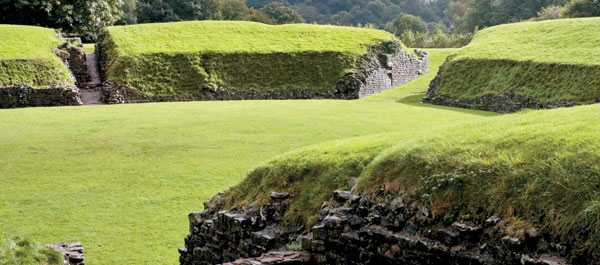
Where ancient history and legend make romance
Almost 2,000 years ago, the small Welsh town of Caerleon on the River Usk was an all mighty, bustling metropolis, its cobbled streets already worn smooth by the foot traffic of Roman soldiers. Today the sleepy village provides perhaps the best evocation in the country of Rome’s three-century military occupation of Britain.
Welcome to Isca, major Roman port on the Severn Estuary and home of the Second Augustan Legion. Its location at the northern headwater of the Bristol Channel proved an ideal base for one of three standing legions of the Roman Army stationed in the Roman-occupied province of Britain. From that strategic spot, the legion could be dispatched across South Wales, into the Midlands or anywhere in southwestern England for any contingency.
Some 6,000 professional soldiers made their home in Isca, recruited into the legion from across the Roman Empire. Recent discoveries on the Usk riverbanks have provided dramatic evidence of the large and busy harbor that existed there in the 200 years of Roman occupation from ad 75. Via the harbor, traces of which had long disappeared, the army was supplied with goods from Rome and across its provinces, reinforced with new postings and communicated with the broader Empire. A constant stream of olive oil and wine, ceramics and tools, dignitaries and dispatch riders arrived in shallow-draft ships on well-known routes that hugged the Atlantic coastline down to the Mediterranean.
If much was expected of the Roman army, much was provided for them as well. A huge complex of heated baths facilitated a recreational regimen and social life as well as hygiene. An amphitheater large enough to accommodate the legion of 6,000 soldiers provided entertainment, spectacle and military competition.
Over the centuries after Rome withdrew its army from Britain, Isca faded into insignificance. The structures and infrastructure of a once vital and affluent military city decayed into nothingness. The valley of the Usk and the neighboring hills became sparsely populated with farms. As happened in many places, the stonework of disused Roman buildings was carted off in bits and pieces to be built into village houses and walls and farm buildings surrounding Caerleon. The silt and soil of the centuries covered much of the evidence of Roman occupation. What remained, however, were the foundations of the only Roman legionary barracks left anywhere in Europe and Britain’s most complete Roman amphitheater.
The army barracks are a parade of housing rows, each row housed a unit of 80 soldiers and their commanding centurion. Eight soldiers shared a two-room apartment. The rear room was the sleeping area, and the front a communal space for equipment and personal belongings. At the head of the block were the larger rooms of the centurion.
Along the embankment beside the barracks rows, the foundations of the kitchen ranges are still intact. In the corner of the block, the elaborate plumbing and foundations of the latrine block are complete enough to identify their functions.
The four files of barracks left visible today could have housed only 320 men. In its heyday, Isca would have required 75 such blocks to accommodate the 2nd Augustan Legion.
It is not that difficult to imagine a legion of 6,000 in place around Caerleon’s amphitheater. The circle is virtually complete, with the entrances for performers, combatants and officials, a shrine to the gods and even what would have been a “green room.”
While most of Isca’s archaeological remains lie underneath the contemporary town of Caerleon, a wealth of finds over the years is gathered in the National Roman Legion Museum on High Street. www.cadw.wales.gov.uk
Through its exhibitions and artifacts the museum does a superb job of explicating life at this furthest outpost of Rome. Just down the street, the Roman Fortress Baths have enclosed an entire recreational complex of heated baths, exercise rooms and an open-air swimming pool. All under cover today, the entire complex closely resembles a modern leisure center. Both offer free admission to visitors. www.museumwales.ac.uk/en/roman
[continued on next page]
